INDIAN ARMED FORCES CHIEFS ON OUR RELENTLESS AND FOCUSED PUBLISHING EFFORTS

The insightful articles, inspiring narrations and analytical perspectives presented by the Editorial Team, establish an alluring connect with the reader. My compliments and best wishes to SP Guide Publications.

"Over the past 60 years, the growth of SP Guide Publications has mirrored the rising stature of Indian Navy. Its well-researched and informative magazines on Defence and Aerospace sector have served to shape an educated opinion of our military personnel, policy makers and the public alike. I wish SP's Publication team continued success, fair winds and following seas in all future endeavour!"

Since, its inception in 1964, SP Guide Publications has consistently demonstrated commitment to high-quality journalism in the aerospace and defence sectors, earning a well-deserved reputation as Asia's largest media house in this domain. I wish SP Guide Publications continued success in its pursuit of excellence.
- The layered Air Defence systems that worked superbly, the key element of Operation Sindoor
- Operation Sindoor | Day 2 DGMOs Briefing
- Operation Sindoor: Resolute yet Restrained
- India's Operation Sindoor Sends a Clear Message to Terror and the World – ‘ZERO TOLERANCE’
- Japan and India set forth a defence cooperation consultancy framework, talks on tank and jet engines
Inspiring Dreams for the Future
This year, the NBAA’s Business Aviation Convention and Exhibition (BACE) was characterised by energy, excitement and had a distinct focus on the future of the business aviation industry

The Business Aviation Convention and Exhibition (BACE) organised by the National Business Aviation Association (NBAA), was held from October 16 to 18 this year at the Orange County Convention Centre and the Orlando Executive Airport in the United States of America (USA). Located in the middle of Florida, Orlando is the third most populous city in the State. Handling primarily business and general aviation operations, the Orlando Executive Airport has been the venue for special events related to the aviation industry. This airport has been showcasing NBAA air show since 2008 and the last such event was held there in 2014.
BRIEF HISTORY OF NBAA
The NBAA was conceived in 1946 by a World War II veteran, Palmer J (Bud) Lathrop, the then Vice President of Bristol Meyers and later President of Cameron Machinery Company. It was he who laid the foundation of this organisation on November 21 the same year. The organisation was initially named as Corporation Aircraft Owners Association (CAOA). Subsequently, on September 24, 1947, in a meeting of all the 19 members who had enrolled with the Association by then, final clearance was given for the establishment of a permanent entity as a not-forprofit corporation. The CAOA was thus later renamed as NBAA and the headquarters of the Association was based in New York. However, its headquarters was subsequently relocated to Washington DC for better interaction with other organisations and Associations related to the business aviation industry.
Today, the NBAA represents more than 11000 companies and is the leading organisation for entities that rely on general aviation aircraft to help them make their business more efficient, productive and successful. It provides more than 100 products and services to the business aviation community which includes BACE or Business Aviation Convention and Exhibition. This is regarded as the largest and the most important event in the domain of business aviation. It is also ranked as the sixth largest trade show in the US and it brings together current and prospective aircraft owners, manufacturers and customers at one meeting place to interact, resolve issues of critical importance for the organisation and chart future course.
THE EVENT THIS YEAR
This year, the Business Aviation Convention and Exhibition or BACE, was characterised by energy, excitement and had a distinct focus on the future of the business aviation segment of the civil aviation industry. Signs at this year’s convention proclaimed, “The future of business aviation starts here.” For once, there were plenty of indications that 2018 could be a turning point for the business aviation sector after suffering the effects of a decade of financial turmoil particularly in the US, its largest market. Forecast by Honeywell this year has been particularly rosy, with healthy economies and new programmes spurring demand for 7,700 aircraft by 2028, an increase of 50 units as compared to last year.
As per Ed Bolen, President and Chief Executive Officer (CEO) of NBAA, who stated, “It certainly seemed that NBAA – BACE exceeded even the highest expectations. Exhibitors told us that their booths were packed and that those who attended the event, continually remarked positively on the latest technologies and services displayed, the impressive show floor, the quality of our sessions and the networking opportunities available.” Ed Bolen went on to say that the positive energy was palpable in every corner of the show floor and static display. “The convention clearly showed that that this is one of the best environments for business aviation in decades. We focussed on the people, technologies and the leadership qualities that will surely maximise opportunities available today while keeping an eye on the investment and innovation that will drive the industry’s future.”
PARTICIPANTS IN THE SHOW
The event this year that was scheduled for over three days, witnessed the presence of more than 1,000 exhibitors to showcase their products of which, 100 were participating for the first time. It also witnessed participation by all the 50 states of the US as also by representatives from 90 countries across the globe. On static display, there were around 110 business aircraft from practically all business aircraft manufacturers in the world. Of these, apart from a brand new model, the Falcon 6X from Dassault Aviation of France, several aircraft that have been in service for some years, were on display for the first time. In fact the array of aircraft of all sizes and all missions, ranging from single-engine piston, turboprops to large intercontinental business jets and rotary wing platforms, were there for people to see. The static display brought together the world’s latest and diverse collection of business aircraft at one location to enable prospective customers to evaluate a wide range of options themselves. Visitors to the show were able to closely examine the wide array of platforms from manufacturers such as Airbus, Bell Helicopter, Boeing, Bombardier, Dassault, Gulfstream and more.
The show also witnessed the emergence of technologies that could take business aviation in new directions. Aerion has been nurturing its AS2 supersonic business jet concept for a decade without the desired level of progress. However, having now entered into key partnerships with GE Aviation and Honeywell, the AS2 supersonic business jet project now appears to be moving forward at a faster pace. Simultaneously, electrically powered air transport is moving closer to reality, with Safran and Uber both revealing details about alternative-propulsion projects.
KEYNOTE SESSIONS
The keynote sessions for the first two days of the show were focussed on visionaries pioneering the future of business aviation. Uber Elevate was in the lead with the company’s plans for facilitating urban mobility through electrically powered vertical takeoff and landing (VTOL) aircraft that can provide highly efficient, rapid and reliable transportation service between as well as within metros and other cities afflicted with perpetually increasing levels of traffic congestion. Eric Allison, head of aviation at Uber Elevate, said that commercial operations could be expected to be happening by 2023 with demonstration flights as early as 2020. Representatives of Uber met operators and pilots as part of the company’s preparation for the launch of its new transportation initiative for urban transport. Cities proposed for the launch of services initially, are Dallas and Los Angeles.
Another individual pioneering the future of business aviation was Bertrand Piccard, Initiator, Chairman and Pilot of Solar Impulse, an aircraft driven entirely by solar power. He narrated his story of flying around the world without consuming any other kind of fuel to propel the aircraft. He exhorted the aviation industry to make the supposedly impossible dream of making solar flight a reality for all. The keynote sessions also featured display for the first time, the Cirrus Vision Jet, the 2018 Collier award winning platform. Also on display was the experimental flying car from Terrafugia that is scheduled to hit the market sometime next year.
The organisers of the event also availed of the opportunity to honour some of the legendary figures in aviation. NBAA’s Meritorious Service to Aviation Award was given to Women Air Force Service Pilots who had rendered service during the Second World War. NBAA also recognised the contribution of aviation legend and performer at air shows, Sean D Tucker as well as the Bob Hoover Academy which he founded in 2016. These two were selected to be honoured for their contribution towards inspiring under-privileged youth through exposure to aviation and teaching them to fly. They were both conferred the prestigious Al Ueltschi Award for Humanitarian Leadership. This clearly underscored the fact that the industry is investing in its future workforce. On the last day of the show, a day that was nominated as the Careers and Business Aviation Day, more than one thousand students came to NBAA-BACE and were provided free entry. Here they got the opportunity to interact with aerobatic pilot Anthony Oshinuga and other mentors.
THE NEXT SHOW IN 2019
Commenting on the show, Ed Bolen said, “The convention this year highlighted the proud history of business aviation, exciting present and inspiring dreams for the future – a future that has never been felt to be so close as it is this week”. Ed Bolen concluded by saying that the NBAA was carrying the excitement forward to 2019 when NBAA – BACE will be returning to Las Vegas NV for a convention in the period October 22 to 24 that year.
Affinity will power the Aerion AS2 supersonic business jet
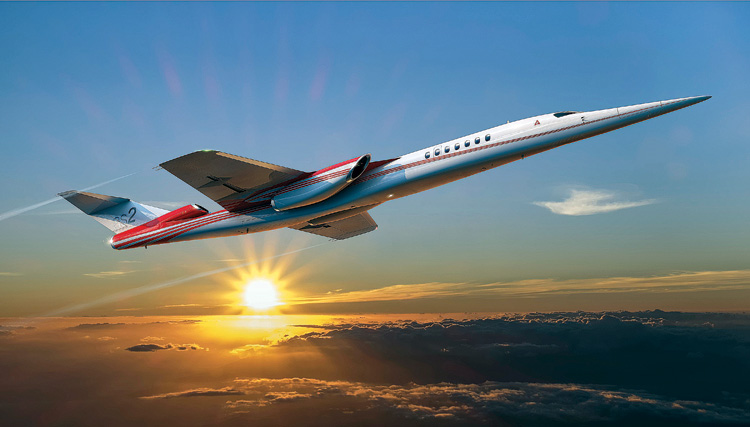
GE Aviation announced that it has completed the initial design of the first supersonic engine purpose-built for business jets. This new engine class, revealed as GE’s Affinity™ turbofan, is optimized with proven GE technology for supersonic flight and timed to meet the Aerion AS2 launch. The Affinity integrates a unique blend of proven military supersonic experience, commercial reliability and the most advanced business jet engine technologies.
GE’s Affinity is a twin-shaft, twin-fan turbofan controlled by a next generation Full Authority Digital Engine Control (FADEC) for enhanced dispatch reliability and onboard diagnostics. It is purposefully designed to enable efficient supersonic flight over water and efficient subsonic flight over land, without requiring modifications to existing compliance regulations. The engine is designed to meet stringent Stage 5 subsonic noise requirements and beat current emissions standards. It features:
- Efficient performance throughout the full flight envelope with a high-altitude service ceiling of 60,000.
- An advanced twin-fan with the highest bypass ratio of any supersonic engine.
- A special, non-augmented supersonic exhaust system.
- A proven engine core adapted from GE’s commercial portfolio.
- A durable combustor with advanced coatings for sustained high-speed operation.
- Advanced acoustic technology.
- GE’s additive design & manufacturing technologies to optimize weight & performance.
The next design review is targeted 2020, signaling beginning of detailed design and test article production.
Falcon 6X Development Accelerates Into Design Phase
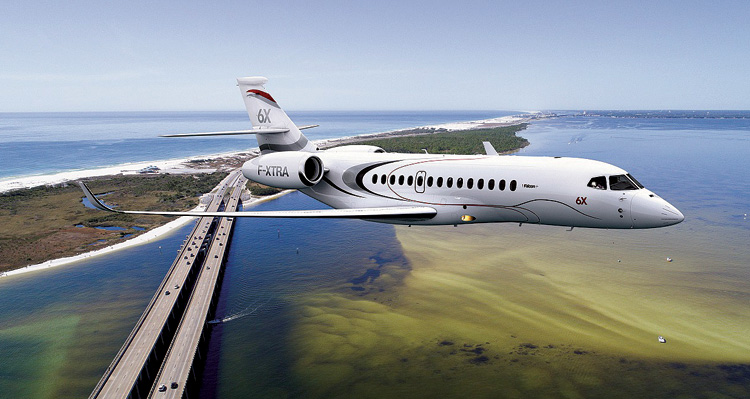
Unveiled earlier this year, Dassault Aviation’s new 5,500 nm/10,186 km Falcon 6X ultra widebody twinjet has completed preliminary design and entered the detail design phase. Production of initial long-cycle structural parts has begun and development tests of Pratt & Whitney Canada’s PW812D power plant are progressing well. Aircraft architecture has been frozen and contracts with all major Falcon 6X program partners have been signed.
“Everything is on track for the Falcon 6X to begin deliveries in 2022,” said Eric Trappier, Chairman and CEO of Dassault Aviation. A full-scale mockup of the 6X’s spacious cabin was on display on the Dassault static display during the NBAA show.
The Falcon 6X will integrate the most advanced design features on the market, drawn from Dassault Aviation’s world-leading business jet and fighter aircraft expertise. It will offer the longest range in its class and unmatched airport performance while providing more interior space than any other aircraft in its category.
The Falcon 6X will incorporate a string of innovative features, including:
- An ultra-efficient wing with advanced structural architecture and curved trailing edge to increase buffet margin and increase lift/drag, reducing the impact of turbulence.
- Flaperons, active high-speed deflection control surfaces that can act as both flaps (increasing lift) and ailerons (improving roll control). The devices will be integrated into the 6X’s nextgeneration Digital Flight Control System (DFCS).
A new onboard integrated maintenance system, FalconScan, capable of monitoring more than 100,000 parameters for real-time system self-diagnosis.
Embraer Introduces the Praetor 500 & Praetor 600
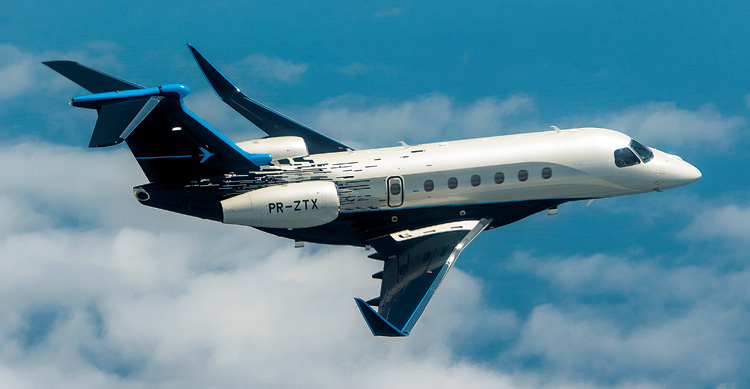
The Praetor 500 and Praetor 600 are the disruptive aircraft for the entrepreneur, for the pioneer, for the innovator,” said Michael Amalfitano, President & CEO, Embraer Executive Jets. “The introduction of these aircraft support our vision of fascinating our customers and providing them with superior value and the best experience in the industry.”
The Praetor jets will introduce unprecedented range into their categories. The Praetor 600 will be the farthest-flying super-midsize business jet, which allows nonstop flights between London and New York. The Praetor 500 will be the fastest midsize aircraft, capable of reaching Europe from the west coast of the U.S. with a single stop. With four passengers and NBAA IFR Reserves, the Praetor 600 will have an intercontinental range of 3,900 nautical miles (7,223 km) and the Praetor 500 will lead the midsize class with a continental range of 3,250 nautical miles (6,019 km).
Advanced technology also abounds throughout the cabin beginning with the industry-exclusive Upper Tech Panel that displays flight information and offers cabin management features also available on personal devices through Honeywell Ovation Select. High-capacity high-speed connectivity for all aboard is available through Viasat’s Ka-band with speeds of up to 16Mbps and IPTV, another industry-exclusive in midsize and super-midsize business jets.
Being the only midsize and super-midsize business jets with full fly-by-wire technology and active turbulence reduction, passengers will enjoy the smoothest possible flight, complemented by a best-in-class 5,800-foot cabin altitude for ultimate passenger comfort. To celebrate these new aircraft, Embraer is also introducing the new premium style Bossa Nova interior edition.
The Praetor jets are currently under development with two Praetor 600 prototypes in flight tests as well as one productionconforming aircraft, and one production-conforming Praetor 500 in its maturity campaign. The Praetor 600 is expected to be certified and enter service in the second quarter of 2019, followed by the Praetor 500 in the third quarter of 2019.
Gulfstream G650 family surpasses 75 sped records
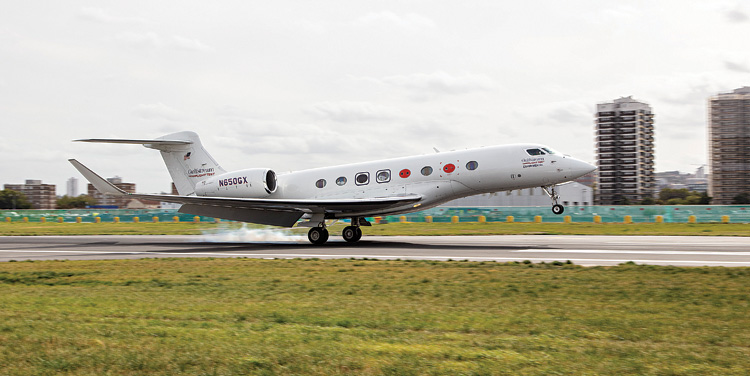
The Gulfstream G650 family has now achieved more than 75 city-pair records, just a few weeks after the ultra-longrange aircraft demonstrated steep approach capabilities at London City Airport. Once approved for London City, the G650 family will be the fastest, largest, longest-range business aircraft to operate at the airport.
“Even with more than 315 G650ER and G650 aircraft in service around the world, we continue to enhance the utility, flexibility and real-world performance of these already class-defining aircraft,” said Mark Burns, President, Gulfstream.
The G650ER demonstrated its performance advantage with the following records, pending approval by the National Aeronautic Association:
- Keflavik, Iceland, to Foz do Iguaçu, Brazil, in 11 hours and 46 minutes at an average speed of Mach 0.90
- Beijing to Paris in nine hours and 18 minutes at an average speed of Mach 0.90
- Tel Aviv, Israel, to Kiev, Ukraine, in two hours and 41 minutes at an average speed of Mach 0.90
- Kiev, Ukraine, to London in two hours and 50 minutes at an average speed of Mach 0.90
Textron debuts new full-scale Cessna SkyCourier mockup
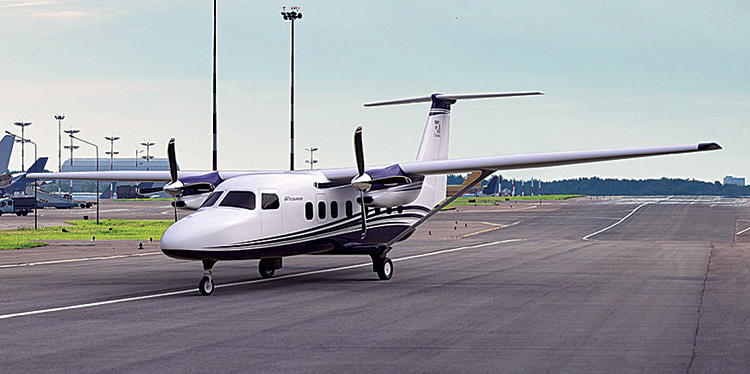
Textron Aviation, unveiled the new full-scale Cessna SkyCourier mockup. The cabin mockup on display at this year’s event offers a preview into the Cessna SkyCourier’s passenger options and standard features.
“The Cessna SkyCourier was engineered to be a versatile, heavy utilization turboprop with significant payload to undertake a variety of missions,” said Rob Scholl, senior vice president, Sales and Marketing. “We’re excited for customers and NBAA attendees to experience many of the aircraft’s distinctive features firsthand.”
Combining form and function, the passenger configuration of the Cessna SkyCourier cabin offers seating for up to 19 with a generous, 32-inch (80 cm) seat pitch and separate entry doors for passengers and crew. Inside the aircraft, a netted rear cabin cargo area can accommodate luggage and equipment, and optional overhead baggage compartments provide additional storage space onboard. USB charging ports are located throughout the seating area, and large windows add natural light for greater comfort onboard.
“Since announcing the Cessna SkyCourier last year, we’ve seen continued interest from operators searching for a modern utility aircraft capable of flexible operations and configurations,” Scholl noted.





